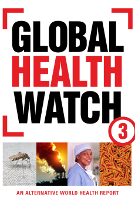4.07 Draft WHO HIV/AIDS strategy 2011–2015
Context of EB Discussions
Following the request to the Director-General in resolution WHA63.19 to submit a WHO HIV/AIDS strategy for 2011–2015, a broad consultation process has informed a draft global health sector strategy for HIV/AIDS structured around four main goals: improving HIV outcomes; improving broader health outcomes; strengthening health systems; and creating supportive environments. The Board is invited to consider the draft strategy (contained in Executive Board document EB128/10) and make a recommendation on its possible endorsement by the Sixty-fourth World Health Assembly.
Background
The draft strategy was developed through a consultative process (including a 7-week online consultation between July and September 2010). It was developed in parallel with UNAIDS 2011-2015 strategy, with the aim of guiding national health sector responses.
The draft strategy supports and reinforces the agreed division of labour among UNAIDS cosponsors. Among the UNAIDS cosponsors WHO is responsible for the health-sector response to HIV, taking the lead on HIV treatment and care and on HIV/tuberculosis co-infection, shares responsibility with UNICEF for the prevention of mother-to-child transmission of HIV, and collaborates with other cosponsors in supporting actions in all other priority areas.
PHM Comment (from letter to EB members)
The progress report (EB128/10) does not discuss barriers to the implementation of the “Three Ones” principle (one agreed HIV/AIDS action framework, one national AIDS coordinating authority, and one agreed country-level monitoring and evaluation system) as provided for in WHA59.12 which urges for the identification of barriers and strengthening of institutional capacity.
The Draft HIV/AIDS strategy should inform AIDS coordination and vice versa, with clear links established between the two. The two items should not be discussed in isolation from one another.
Intellectual property rights, and the resulting unaffordability of diagnosis and treatment, should be acknowledged as a barrier to reaching the ultimate objective of implementing the Three Ones principles. The Draft HIV/AIDS Strategy mentions it, so it should be reflected here as well so that coordination efforts could be directed its way (with the UNDP, for example).
According to WHA59.12, the DG is requested to prepare a plan of action for the implementation of the recommendations of the Global Task Team, and to provide effective technical support at national level. In the progress report (para. 92), there is mention of a UNAIDS technical support strategy to which the WHO has contributed, and is “elaborating a plan to outline WHO’s role and contributions”. Member States should ask for this plan of action (on WHO’s role and contributions) to be developed and set a deadline for this.
Under the revised UNAIDS division of labour, according to the progress report (para 93), the WHO continues to lead the health sector response to HIV. However, the report is not clear as to how the contribution of the WHO in these areas will see improved coordination among multilateral and international bodies, or, better, how such coordination of efforts could strengthen such an exercise.
With regard to monitoring and evaluation, it is not clear whether using the term “improving” the performance of Joint UN Teams on AIDS (para. 94 of progress report), entails some monitoring and evaluation mechanism in place (in line with the Task Team recommendations under Accountability and Oversight). Developing the capacity of monitoring and evaluation at national level should also be covered by technical support activities (covered under para. 92), because it is a crucial element for sustainability of HIV response.
The close cooperation between WHO and the GF on technical support issues should not be confined to countries who succeed in receiving GF. There are developing countries which are in need of technical support, but which often fail the GF “application process”. They should not be deprived of such support.
It has been recognised that access to affordable HIV-related medicines is hampered by the failure of countries to use safeguards available in the TRIPS agreement (with reference to the Doha Declaration in a footnote). However, there is no reference to the failure of the para 6 system of the Doha Declaration in helping LDCs with no pharmaceutical manufacturing capacity access medicines (Canada-Rwanda case), and of its review process at the TRIPS council. The WHO, as the UN organisation mandated with health matters, should take the lead on this, rather than WTO on its own.
There is no mention of TRIPS-plus provisions in bilateral trade agreements through which developing countries give away their TRIPS safeguards.
There is a need for technical assistance on health-related IP matters, which should be specified under the implementation section (Table 6, p. 52), where the WHO collaborates with the UNDP. This is being called for at other UN organisations such as WTO and WIPO, and developing member states are also questioning the content of existing technical assistance programmes provided to developing countries. The WHO should take the lead on such health-related discussions, and there is also a need for more information about specific ways in which the WHO will contribute.
Under Health financing (p. 27) the draft strategy calls for the adoption of approaches to minimise out-of-pocket expenditure, but places mobilisation of donations for adequate funds as a first element, further reinforcing a vertical donor-centred approach. The immediate interpretation is that prices, hence big pharma commercial interests, are not to be negotiated.
The vertical approach, which is criticised for being unsustainable, should be addressed through strengthening national capacity, namely health regulatory and legislative capacities. Investing in local pharmaceutical manufacturing capacity also provides a sustainable solution away from the vertical approach.
| Attachment | Size |
|---|---|
| WHOWatch(EBJan128)_DraftHIV-AIDSStrategy.pdf | 155.49 KB |




